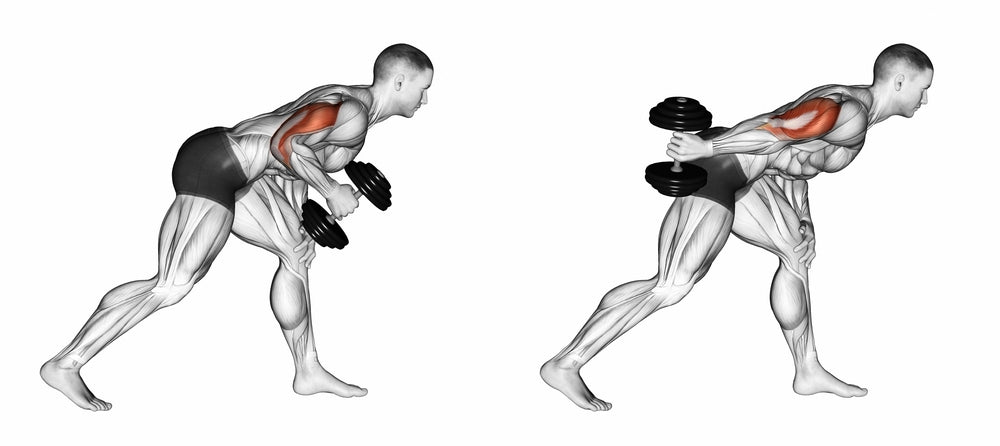Exercise Anatomy
Triceps Kickback
Define your triceps with precision using Triceps Kickbacks - an isolation exercise designed to specifically target the back of your arms. This straightforward movement not only enhances muscle tone but also engages your triceps in a unique way. Add Triceps Kickbacks to your routine for a quick and effective method to sculpt strong and sculpted arms.

Major Muscles and Actions Involved
The Triceps Kickback is a targeted exercise primarily focusing on the joint action of elbow extension. As you perform this movement, the elbow joint extends, emphasizing the activation of the triceps brachii muscles.
Engaging in Triceps Kickbacks places a specific demand on the triceps brachii, the three-headed muscle located at the back of the upper arm. This exercise isolates the triceps, emphasizing their role in extending the forearm. Additionally, the anconeus, a smaller muscle adjacent to the triceps, is also involved in supporting elbow extension during the Triceps Kickback.
The movement involves straightening the arm against resistance, effectively working the triceps to achieve greater strength and definition in the back of the arms. The simplicity and targeted nature of Triceps Kickbacks make them an efficient choice for isolating and sculpting the triceps muscles.

Sports Uses
The Triceps Kickback, with its emphasis on isolating and strengthening the triceps, offers direct benefits in various sports where upper body strength and arm definition play pivotal roles.
In the realm of tennis and badminton, where powerful arm movements are essential for serves and smashes, the Triceps Kickback becomes a valuable exercise. It targets and enhances the triceps, contributing to the explosive strength needed for forceful shots on the court.
For athletes engaged in boxing and mixed martial arts, where effective striking relies heavily on strong and well-defined triceps, Triceps Kickbacks serve as a strategic addition to training routines. This exercise hones the muscles crucial for delivering powerful punches, promoting improved performance in the ring.
Weightlifters, particularly those specializing in overhead lifts like the snatch and the jerk, benefit from the Triceps Kickback to reinforce the triceps' role in extending the elbow. This targeted exercise supports the lockout phase of these lifts, contributing to greater stability and efficiency.
In the world of bodybuilding, where sculpted arms are a sought-after aesthetic, Triceps Kickbacks are a staple for isolating and defining the triceps. Bodybuilders incorporate this exercise to enhance the overall appearance of their arms during competitions.
Furthermore, in sports like swimming, where strong and streamlined arm movements are essential for propulsion in the water, the Triceps Kickback can be a supplementary exercise. It aids in developing the triceps strength needed for efficient strokes and contributes to enhanced swimming performance.
In essence, the Triceps Kickback proves to be of direct benefit in sports that demand upper body strength, power, and aesthetics. Its ability to isolate and strengthen the triceps makes it a valuable tool for athletes across various disciplines, contributing to improved athletic performance and arm definition.
Exercise Tips
- Technique:
Ensure proper technique during Triceps Kickbacks by maintaining a stable torso and a slight bend in the knees. Hinge at the hips to bring your upper body parallel to the ground. Keep your upper arms close to your torso, and extend the forearms backward, fully contracting the triceps at the top of the movement. Avoid excessive swinging or using momentum, focusing on controlled and deliberate movements. - Range of Motion:
Emphasize a full range of motion to effectively engage the triceps. Fully extend your arms backward until they are straight, emphasizing the contraction of the triceps at the top of the movement. Avoid shortening the range, as this may limit the effectiveness of the exercise in targeting the triceps muscles. - Amount of Weight Used:
Start with a moderate weight when incorporating Triceps Kickbacks into your routine. Focus on maintaining proper form and feeling a strong contraction in the triceps at the top of each repetition. Gradually increase the weight as your strength improves, ensuring that you can control the movement throughout the set. - Variations:
Experiment with different variations of Triceps Kickbacks to target the triceps from various angles. You can use dumbbells, cables, or resistance bands to add variety to your triceps training. Changing the angle or the equipment can provide a diverse stimulus, promoting overall triceps development. - Breathing:
Establish a consistent breathing pattern to support your movements during Triceps Kickbacks. Inhale as you prepare for the extension, and exhale forcefully as you extend your forearms backward. This controlled breathing not only enhances stability but also contributes to overall focus and efficiency during the exercise.
